Services- Phonetic System
Riggs’ Content, What We Teach
Writing and Spelling Road to Reading and Thinking
Phonetic Content/Handwriting:
Instruction begins by teaching the sound(s) of, and letter formation for (manuscript writing), the Riggs Institute’s 71 Writing and Spelling Road to Reading and Thinking “Revised” Orton Phonograms [a phonogram is a letter or combination of letters which stands for one sound in a given word OR a phonogram is a combination of phoneme and grapheme] which are the commonly-used correct spelling patterns for the 45 elementary sounds of English speech.
Most English-speaking children can say these sounds and put them in some 4000 to 24,000 words which they use in oral sentences that they comprehend before they enter grade one.1.
1Seashore, Robert H. Journal of Educational Psychology, Volume 31, January, 1940, pages 14 through 38.
The purpose for teaching the sound/symbol relationships first, in isolation, without key words or pictures (this is “explicit” phonics), is to give students, quickly, the information they need to spell and write, correctly, what they can already hear, say, and comprehend orally! There are 118 combinations in the following chart which, for this illustration, show “key” words to demonstrate the sound(s) of each letter or letter combination taught. The key words are for the teacher’s use only in determining the correct sound(s) for this initial instruction.
71 REVISED “ORTON” PHONOGRAMS FOR CORRECT SPELLING
[bring the Orton orthographic spelling system into closer compliance with Merriam-Webster’s Collegiate Dictionary, and render almost any text “decodable”]
GLOSSARY AS USED IN THIS METHOD OF INSTRUCTION:
• Phonogram – Is a combination of phoneme and grapheme. When these phonograms are spoken, they are phonemes; when they are written, they are graphemes.
• Phoneme (sound) – An elementary sound of English speech.
• “Elementary” Sound – One which cannot be further divided (these are never blends such as str, bl, or nd which simply combine two or more elementary sounds).
• Grapheme (letter/s) – A written symbol (letter or letters) which represents a phoneme on paper, i.e., the phoneme /oo/ is commonly written with food, do, dew, due, fruit, through, you, shoe, neutral, two, lieu view graphemes
The following consonant phonograms were FORMERLY taught in most basal reading methods though they were not taught “explicitly” as compiled research (BNR) has recommended since 1985. In this method, two sounds for the consonants c, g and s are taught immediately and q is taught with u with which it is always used. Only the sound/s (phonemes) are dictated as the letters (graphemes) for them are written. Students SEE, HEAR, SAY and WRITE these phonograms (letter/sound combinations) using multi-sensory instruction to address all “learning styles”. The
key words shown here are for the teacher to determine the correct sounds only; key words, pictures, upper case letters and letter names are never used to teach “explicit” phonics:
b (bat) c (cat, cent) d (dog) f (fed) g (got, gentle) h (hot) j (jog) k (keg) l (lid) m (mop)
n (no) p (put) qu (quit) r (run) s (sit, days) t (top) v (vase) w (wag) x (box) y (yet) z (zip)
Next are the vowels. The multiple phonemes (sounds) as shown in the key words are taught immediately and together, i.e., the letter a becomes aaah, long a, ah and aw. Generally, the sounds of all the phonograms are taught in the order of their frequency of use in English. The third sound of i and the fourth sounds of a, o, and u are needed early for both spelling and reading of simple words. Note: Vowel y takes the place of i for spelling, and is used as both a
vowel and a consonant:
a (at, ate, want, talk) e (end, we) i (it, silent, radio)
o (dot, open, do, cost) u (up, music, blue, put)
y (myth, my, baby)
These common combinations are not consistently taught in most methods though they are needed for correct spelling. Very often the letter, “r” is taught as “er” or “ruh” which is incorrect. Spelling errors, poor auditory discrimination/processing and impaired phonemic awareness are already common, but seriously deteriorate by mispronouncing the 45 elementary phonemes as they are taught. The key words are taught only with this group since it is the only way to designate which grapheme is meant:
er [the er of] (her) ur (nurse) ir (first) or (works) ear (early)
oa [the o of] (boat) oe (toe)
This grouping is taught in pairs (top to bottom listing) to illustrate their uses for spelling:
ay (pay) oy (boy) aw (law) ew (grew, few) ey (they, key) [used at the end of words]
ai (paid)
oi (boil) au (fault) eu (neutral, feud) ei (veil, receive) [not used at the end of words]
The common spellings of sounds – “sh” and “zh” – are taught before the tenth week of instruction in this method:
sh [used at the beginning of a word (shut), at the end of a syllable (push) but not at the beginning of any syllable after the first one (na tion) except for the ending “ship.” (friendship).]
ti (nation) si (session, vision) ci (special)
[all used to spell “sh” or “zh” (session, equation) at the beginning of any syllable after the first one].
The next group are 2, 3 and 4-letter spellings of sounds more commonly represented by only one letter. Children can fail to learn to read or spell because they don’t know these very commonly used alternate spelling patterns:
ck (neck) 2-letter “k” dge (badge) 3-letter “j” tch (catch) 3-letter “ch”
[all used after a single vowel which says the short sound of a, e, i, o, u.]
kn (knee) 2-letter “n” [used to begin a word] gn (reign, gnaw) [used to begin & end a word]
ee (feel) e – double e says “e” igh (high) 3-letter “i” eigh (eight) 4-letter “a” wr (write) 2-letter “r”
ph (phone) 2-letter “f”
These phonograms are rarely taught and practiced but are essential phonetic information for
accurate spelling and fluent reading. Again, each sound is illustrated here in the order of its
frequency of use, using this spelling pattern, in English words.
ow (now, low) th (think, this) ch (chin, school, chef)
ng (ring) ea (eat, head, break) ou (out, four, you, country)
ar (far) ie (field, pie) ed (started, loved, missed) [ past tense ending]
wh (when) oo (boot, foot, floor) ui (fruit, guide, build)
or (for) ough (though, through, rough, cough, thought, bough)
NOTE:TO ORDER Writing and Spelling Road to Reading and Thinking “Revised” Orton Phonogram and the, the Writing and Spelling Road to Reading and Thinking “Revised” Orton Phonogram Sound CD with which you can accurately teach these sound/symbol relationships to students of any age or virtually any ability, click on “Catalog” on the link bar on this same page or on our home page (these items are shown on the first and second pages in our catalog). They teach critical information — the unknown symbols (letter/s) for the known sounds (phonemes) children have been using in conversation since they learned to speak. We say “k” “aah” “t,” for “cat” — not “see-a-tee.”
Primary children learn the first 55 of these phonograms in the first 3 weeks of instruction at the rate of 4 per day.
They learn listening, auditory discrimination and processing, letter formation, spacing, margins,
directionality, linear eye movements, spatial relationships, etc. simultaneously.
The method moves logically and directly from the “known” sounds to teaching the “unknown” symbols which represent them in print. Consonant blends (i.e., bl, str, nd) are taught through the spelling and blending process only, not as isolated phonograms. The multiple-letter phonograms (i.e., au, oi, ew) either form a new sound by having been combined OR they represent a sound more commonly spelled with one letter (i.e., wr, ph, dge).
All of these direct sound/symbol relationships are firmly established in the first 9 weeks of instruction – a period of “reading and writing readiness.” Letter names, key words, pictures and capital letter formation are not taught in initial instruction because they tend to slow the automaticity needed in the direct “sound-to-symbol” response needed for both fluent writing/spelling and reading. Consonant names are never heard in speech, the vowels only about 1/3 of the time, and the great majority of book print is in lower case. Both letter names and uppercase letter formation are learned a little later for dictionary work and for composition.
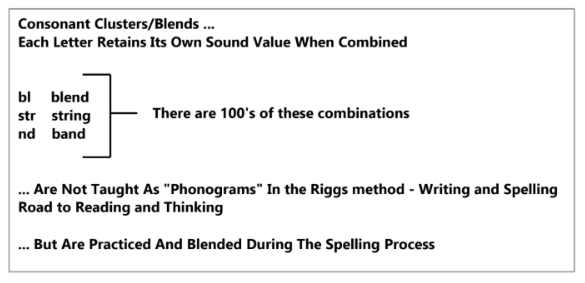
Margins and spacing, as well as letter formation which prevents or corrects early tendencies to reversals, are taught with the sound/s using oral dictation [the graphemic symbol/s (letter/s) are united with the sounds immediately], dotted-line paper and 8 checkpoints.” Checkpoints; 2, 10, 8 and 4 on a clock face, top line, bottom line and 2 dotted-middle lines.
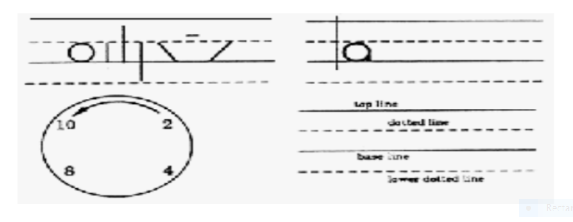
Instructions for the teacher are on the backs of the phonogram cards as in the examples shown here:
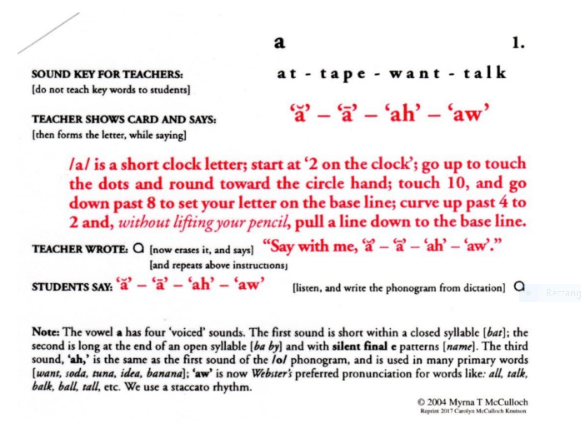
You will note, too, that the student/teacher dialogue really “forces” the use of multi-sensory instruction. Students also develop cognition in auditory and visual discrimination, learn to listen intently, to process oral information and act upon it, and to speak precisely. Visually, they practice to
distinguish shape, form and configuration through print comparisons — a critical need for about 30% of students who begin school with limited “visual or perceptual” abilities (possibly inborn much as color blindness or tone deafness is). Additional auditory, visual, verbal, visual motor and tactile cognitive sub-skills such as directionality, linear eye movements, spatial relationships, sequencing, attention, memory, closure, articulation, tone and rhythm are also carefully developed through the process by which we teach these phonograms.
The “learned” phonograms are then applied in written spelling through a Socratic and dictation process using 47 spelling, syllabication, plural, apostrophe and capitalization rules of the language using teacher “modeled” sentences for immediate applications in context, vocabulary and comprehension. The 47 rules follow:
47 SPELLING, PLURAL, SYLLABICATION, CAPITALIZATION AND APOSTROPHE RULES CONSONANT RULES:
1. The letter q is always followed by the letter u, and we say “kw.” [quiet]
2. /c/ before e, i or y says ‘s.’ [chance, icing, icy]
3. /g/ before e, i or y may say ‘j.’ [germ, giant, gym]
4. We often double l, f and s following a single vowel at the end of a one-syllable word. [ball, off, miss]
5. Two-letter ‘k’ (ck) is used only after a single vowel which says short ‘ă’ – ‘ĕ’ – ‘ĭ’ – ‘ŏ’ – ‘ŭ’ [pack, peck, pick, pock, puck]
6. Three-letter j (dge) is used only after a single vowel which says short ‘ă’ – ‘ĕ’ – ‘ĭ’ – ‘ŏ’ – ‘ŭ’ [badge, ledge, ridge, lodge, fudge]
7. The letter z, never s, is used to say ‘z’ at the beginning of a base word. [zoo]
8. The letter s never follows x.
9. Double consonants within words of more than one syllable should both be sounded for spelling. [hap py]
10. s-h is used to say ‘sh’ at the beginning of a word, at the end of a syllable, but not at the beginning of most syllables after the first one except for the ending ship. [she, wish, friendship]
11. t-i, s-i, and c-i are used to say ‘sh’ at the beginning of any syllable after the first one. [nation, mansion, facial]
12. s-i is used to say ‘sh’ when the syllable before it [session] or the base word ends in an -s [tense/tension]; s-i can say its voiced ‘zh’ sound when s is between two vowels. [vision]
VOWEL RULES:
1. Vowels a, e, o, u usually say long ‘ā’ – ‘ē’ – ‘ō’ – ‘ū’ at the end of a syllable. [pa per, be gin, o pen, u nit]
2. Vowels i and o may say long ‘ī’ and ‘ō’ when followed by two consonants. [find, old]
3. Vowels i and y may say ‘ĭ’ at the end of a syllable [fam i ly, bi cy cle], but usually say ‘i’ or ‘ē’ [pi an o, ba by, by, fi nal]
4. Vowel y, not i, is used at the end of English words. [by, guy]
5. Base words do not end with the letter a saying long ‘ā’ (except for the article a); a-y is used most often. [play]
6. o-r may say ‘er’ when w comes before the o-r. [works]
7. We use ei after c [receipt], if we say long a [veil], and in some exceptions. [neither, foreign, sovereign, seized, counterfeit, forfeited, leisure, either, weird, heifer, protein, height, feisty, stein, weir, seismograph, sheik, kaleidoscope, Geiger counter, etc.] This is not an exhaustive list
of exceptions.
8. Silent final e’s:
9. Job 1. Silent final e lets the vowel say its name. [time]
10. Job 2. English words do not end with v or u. [have, value]
11. Job 3. Silent final e lets c and g say their second sounds. [chance, charge]
12. Job 4. English syllables must have a written vowel. [ta ble]
13. Job 5. No job e [none of the above, e.g., are, horse]
AFFIX RULES:
1. All, till and full are usually written with one l when added to another syllable. [almost, until, careful]
2. The past tense ending e-d says ‘d’ or ‘t’ after words that do not end with d or t [warmed, baked]; otherwise e-d forms a second syllable. [grad ed]
3. Final y is changed to i before a suffix that does not begin with i. [cry, cried, cry ing]
4. When adding a consonant suffix, silent final e words usually keep the e [safe ty, shame less, move ment], but not always. [wis dom, tru ly, ninth]
5. When adding a vowel suffix, silent final e words are written without the e. [time, timing]
6. When adding a vowel suffix to a one-syllable word ending with one short vowel and one consonant [hop], double the final consonant. [hopping]
7. When adding a vowel suffix to a two-syllable word ending with one short vowel and one consonant, double the final consonant if the accent is on the last syllable [admit ́, admitted] unless the suffix throws the accent back to the first syllable. [refer3, referred, ref ́er ence; confer ́, conferred, con ́ fer ence]
8. When prefixes dis, mis and un are added to root words beginning with the same letter with which the prefix ends, this letter will be doubled. [unnecessary, dissolve, misspell]
PLURAL RULES:
1. The plural of most nouns is formed by adding s. [boys, cages, horses]
2. Nouns ending with the sounds of s, x, z, ch, sh or ‘j’ form their plurals by adding e-s. [fox es, bush es, boss es]
3. Nouns ending in y after a vowel form their plurals by adding s. [mon key/mon keys]
4. Nouns ending in y after a consonant form their plurals by changing y to i and adding e-s. [pup py/pup pies]
5. Nouns ending in o after a vowel form their plurals by adding s. [pa ti o / pa ti os]
6. Nouns ending in o after a consonant usually form their plurals by adding e-s [he ro/he roes] B except some musical terms. [pi an o/pi an os]
7. Most nouns ending in f and f-e form their plurals by adding s [belief / beliefs]; some change f to v and add e-s. [wolf /wolves, wife /wives]
8. Most verbs form their third person, present, singular as if they were nouns becoming plurals. [cuts, raises, dresses, fixes, fizzes, catches, pushes, plays, carries, goes]
SYLLABICATION RULES:
1. A one-syllable word is never divided. [boat, good, knelt]
2. A compound word is divided between the words that make the compound word. [shot gun, sun set, air plane]
3. Divide between two consonants [hap py, per haps] unless the consonants form a digraph and are sounded together. [ma chine, e le phant]
4. When a word has an affix, it is divided between the root and the affix. [re run, soft ness, cry ing]
5. When a single consonant comes between two vowels, it is usually divided after the consonant if the first vowel is short. [clev er, lem on, rob in]
6. When a single consonant comes between two vowels or vowel sounds, it is usually divided before the consonant if the first vowel is long. [mu sic, po lite, pa per]
7. Divide between two vowels when they are sounded separately. [di et, cru el]
8. 43. Vowels that are sounded alone form their own syllable. [dis o bey, a live, u ni form]
9. When a word ends in l-e preceded by a consonant, divide before the consonant. [tur tle, ca ble, this tle]
CAPITAL LETTER & APOSTROPHE RULES:
1. Capitalize words which are the individual names or titles of people, of places, of books, of days and months, etc. [Bill, Chief Sitting Bull, New York, Amazon River, Call of the Wild, Sunday, June]
2. An apostrophe takes the place of missing letters in a contraction. [it is/it’s; she is/she’s; cannot/can’t]
3. An apostrophe shows ownership or possession [Mary’s coat, boys’ coats], but is never used with any possessive pronouns. [my, mine, yours, his, hers, ours, theirs, its, whose]
SOUND KEY — HOW TO PRONOUNCE THE RULES
1. Say all sounds of phonograms written between forward slashes /o/.
2. Say names of single or hyphenated letters shown in bold (l, f, s; s-i, l-e).
3. Say the sound of phonograms within quotation marks (“ck”), with mnemonic markings, or with diacritical dictionary markings (with or without quotation marks).
4. Do not say anything shown in brackets [dge; cry crying] when teaching the rules. These are illustration words for the teacher’s use only.
5. Do not teach rule numbers to students; they must articulate the rule itself as each is applied in dictated spelling, reading, blending and decoding lessons.
© 2004 Myrna T. McCulloch
The rules are most effectively taught when the phonograms are applied, sound by sound, in written,
dictated spelling lessons – not by rote memorization. Students learn the “process” of analysis and
thinking simultaneously and with appropriate repetition until the concept is mastered.
Syllabication: Students are taught, through dictation only (no copying), first to say the word, break it into syllables, and write (or encode) it from the spoken sounds (spell). They dictate (or recode) it back to the teacher in the same manner as she/he writes it on a board (or overhead transparency). They compare it “visually” to what they have written; rules and markings are applied together, then the students sound it again (decode), blend it, and begin to read the 2500 most commonly used English words
The mnemonic marking system used enables students to automatically see whole words through
these “sounded” spelling patterns (not merely individual letter sounds) which is critical for fluency in
reading – the primary prerequisite for comprehension.
Here are a few examples of “voiced” sounds in words which are frequently misunderstood and
misspelled when inaccurate, incomplete or delayed teaching of phonetics occurs:
ch ur ch (6 letters but only 3 “voiced” sounds – this “ch” sound comes from the Anglo-Saxon, rather than the Greek-Roman spelling pattern in echo, chorus, or French “ch” in chic and machine)
f igh t (Many older children and adults have never been specifically taught that /igh/ stands for the long i sound when it is written together in a word. They try to sound each letter separately which hardly yields the same word)
th ough (The /ough/ phonogram is taught with 6 sounds as in though, through, rough, cough, thought and bough)
e dge (The /dge/ phonogram is used to say “j” after a single vowel saying its soft sound, i.e. badge, ridge, lodge, budge)
/eigh/ (4-letter a; the long sound of a is also commonly spelled with a, ea, ei, ey, ai and ay)
pa ck (The phonogram /ck/ is used to say “k” after a single vowel saying its soft sound, i.e. peck, pick, pock, puck, rather than using c or k or ch which also say “k”)
start ed (The phonogram /ed/ says “ed” after verbs which end in d and t)
miss ed (The phonogram /ed/ also says “t” in some past tense endings
lov ed (And /ed/ says “d” in still other past tense endings) The /ed/ in red, of course is not a phonogram because it is not a past tense ending.
This phonetic and rules-based English spelling system is set apart from other methods in the following unique and additional ways:
1. Formal instruction begins in the fourth week.
2. Rules are taught through application only, not by rote memorization.
3. Consonant clusters (blends) are taught through dictated spelling and reading only, not as phonograms, which prevents loss of auditory discrimination and processing skills, phonemic awareness, etc.
4. Teaching around the “schwa” (“uh” sound for vowels a, e, i, and o in unaccented syllables) and “regional” pronunciations by specifically stressing “what we must think to spell and write correctly” rather than what we sometimes “hear” or “say” in the rhythm of speech. i.e. (ugenst/a
gainst – ider/idea)
5. Teaching exceptions to rules and not teaching rules which are inconsistent most of the time, i.e. “When two vowels go walking…” i.e. (speak, bread, break)
6. Using a memory device or mnemonic marking system instead of conventional dictionary markings (children already can pronounce and comprehend the words they are now learning to spell)
7. Using phonetic analysis and rules to develop a “sight” vocabulary – a necessary prerequisite for fluency in reading which must happen before the mind “frees” for comprehension.
8. Spelling is addressed first. Though it is more difficult than reading, it is also much more easily organized with the rules and a complete phonetic base. Students who spell and write well, also read while the reverse is frequently untrue.
Students begin oral sentences using the spelling words, in the 5th week. This practice meets research recommendations of the contextual use of words in sentences, followed, in the 7th or 8th week, by written sentences (one sensible requisite of the popular “whole language” programs) that the young authors then read aloud to the class. This is their first, formal reading in context. Some samples follow:
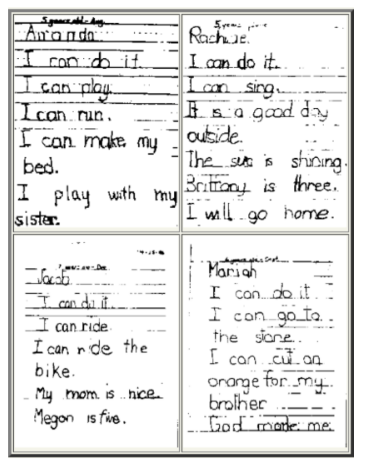
Students, who have been carefully taught these basic writing and spelling skills, in this order, in this “reading readiness” stage, are successful with initial reading attempts because they are reading what they have correctly spelled and written themselves. This prevents the trauma of early failure, and leads directly to an appreciation for authorship and a love of literature which educates (this can be their science or social studies texts to take their language arts instruction “across the curriculum”), AND entertains, and which more nearly meets interest, speech and vocabulary levels years sooner than the norm. We believe that young students who have the entire world in their livings rooms, via National Geographic, Discovery and, perhaps, some other less recommended video, are not even slightly interested in the equivalent of “See Dick run” and certainly not in the current crop of insipid dumbed-
down vocabulary “decodable” texts.
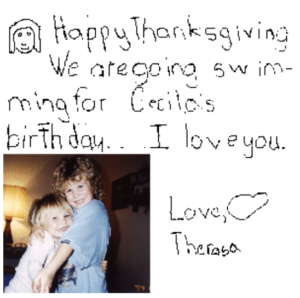
Paragraphs, stories and letters quickly follow. After two months of instruction, kindergartner Theresa wrote her grandmother at Thanksgiving:
She loved this “real” assignment!
Students are being prepared to take their new skills to interesting literature and to continue into the study of syntax and grammar including punctuation and capitalization (much of which is taught through the creative writing process), and which The Writing and Spelling Road to Reading and Thinking includes. Students’ first diagramming is done by separating subject and predicates in their daily sentences, then identifying nouns, verbs, adjectives, adverbs, etc. — in the sentences they are writing — always allowing sufficient time for practice and mastery before going on. Individualized instruction and homework assignments allow creativity for both teacher and student. Children are not given homework assignments they are not equipped to handle themselves.
Here are some sample grammar wall charts prepared with and used by young students:
Grammar Charts:
| POSSESSIVE NOUNS/PRONOUNS (shows ownership) |
|||
| Pronouns (replaces noun) |
Nouns | ||
| Singular (one only) |
Plural (more than one) |
||
| it | its | man’s coat | men’s coats |
| his | his | car’s tires | children’s game |
| her | hers | Bill’s work | students’ grades |
| You | your | boss’s office | girls’ lunches |
| DIAGRAMMED SENTENCE MODELS | |||
| I | love my mother. | |||
| Billy | is my friend. | |||
| We | went to school. | |||
| Also see models in our Complete Book of Diagrams and throughout our Level 1 Teacher’s Edition. | |||
| NOUNS AND THEIR PLURALS [name of person, place or thing] |
|||
| Proper [particular] |
Common [any] |
Plural Form | |
| Regular | Irregular | ||
| Monday | day | days | |
| Sunday | |||
| December | month | months | |
| man | men | ||
| goose | geese | ||
| peach | peaches | ||
| baby | babies | ||
| Lassie | dog | dogs | |
© Riggs Institute
